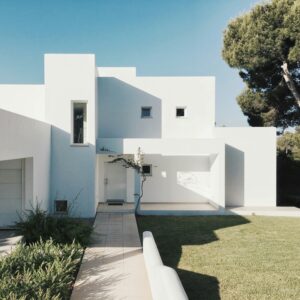Danielle Naftali Discusses the Rigorous Amenity Selection Process, Affordable Luxury Developments, and Optimism for Fort Lauderdale
Danielle Naftali holds a diverse portfolio of roles within the Naftali Group, a prominent real estate firm headquartered in New York. Founded by her family, the company specializes in identifying, acquiring, and developing undervalued properties in prime locations with significant growth potential. As the Executive Vice President of Marketing, Design, Sales, and Leasing, Naftali orchestrates the entire development journey, from inception to fruition, primarily focusing on projects in New York and South Florida. Her responsibilities span from conceptualization and design to project branding, marketing, and devising sales and leasing strategies.
Naftali emphasizes her hands-on involvement throughout the entire development timeline, which can often stretch from five to seven years or more. From initial site assessment to the final delivery of keys to residents, she ensures meticulous attention to detail at every stage. Unlike some firms that segregate design and sales functions, Naftali Group adopts a holistic approach, with Naftali herself overseeing the entirety of the process.
In a recent discussion with Mansion Global, Naftali shed light on the company’s unique development and design philosophy, emphasizing its profound impact on the real estate landscape.

Mansion Global: How do you approach a new project?
Danielle Naftali: Our approach hinges on a deep understanding of the market dynamics. Rather than imposing personal preferences on a project, we invest significant time and effort into comprehending the demographic makeup and neighborhood requirements. This enables us to tailor the amenity package to meet the specific needs of the community. The approach varies not only between cities like Miami and New York but also within different neighborhoods. For instance, our strategy for the Upper East Side differs from that of Williamsburg in Brooklyn.
We prioritize quality over quantity when it comes to amenities. Instead of focusing on creating the largest or most extensive amenity package, we concentrate on curating spaces that are both functional and appealing to prospective buyers or renters. Each amenity is meticulously designed to serve as an extension of the living space, enhancing its utility and attractiveness.
The feedback we receive reaffirms the success of our approach. Residents appreciate the thoughtfulness and craftsmanship put into the amenities, often utilizing them for various purposes, including hosting gatherings, celebrating special occasions, or conducting professional meetings. Our amenities are not just spaces; they serve as vibrant hubs within the community, fostering engagement and enriching residents’ lifestyles.
What amenities differentiate JEM Private Residences in Miami from those offered in Manhattan and Williamsburg?
In Miami’s JEM, we’ve prioritized health, wellness, and indoor/outdoor living. Residents can enjoy a plethora of facilities including a pool, salt room, sauna, steam room, and meditation lounge. Our fitness area features an outdoor boxing ring accessible through sliding doors, along with a yoga studio complemented by a mist garden and cold plunge. A private indoor/outdoor dining area allows residents to host gatherings or enjoy meals in an extended living space with stunning views from the 50th-floor club level.
In Manhattan, at properties like the Bellemont and Benson, the focus shifts more towards spacious units within boutique buildings. While the amenity offerings may be smaller in scale, residents benefit from the exclusivity of a full floor spanning 5,000 to 7,000 square feet with direct elevator access. Amenities in these buildings, such as a squash court, cinema, kids’ playroom, and fitness room, cater to the family-centric neighborhood.
At 200 E. 83rd St. in Manhattan, we’ve reimagined the concept of luxury living with a 75-foot lap pool boasting 40-foot ceilings on the 20th floor, offering panoramic views of Central Park. Additionally, recognizing the scarcity of parking in the city, we’ve introduced a porte cochere for convenient drop-offs, deliveries, and access to a fully automated private underground parking system.
In Williamsburg, where we’re soon launching a new project, residents can anticipate a holistic club floor experience akin to the offerings at JEM in Miami.
How do you integrate feedback into your planning process?
Feedback plays a pivotal role in our planning process. Whether it’s gleaned from our own projects or observations of other developments in the market, we actively incorporate insights into our decision-making. This feedback informs our programming and design choices. For instance, at 200 E. 83rd St., we identified that the pool was a significant selling point for residents. This amenity resonated so strongly that individuals who had never considered living east of Third Avenue were drawn to the building. Such feedback guides our approach to programming and design, ensuring that our offerings align with market preferences and demands.
Where does JEM stand within Miami’s real estate landscape?
JEM occupies a unique position within Miami’s real estate scene. Unlike many neighborhoods in Miami, which lack walkability and cohesive urban planning, JEM stands out as an urban oasis. Situated in the vibrant Miami Worldcenter, one of the few areas with a well-defined master plan, JEM offers residents a truly integrated living experience. As Miami Worldcenter nears completion over the next few years, residents will enjoy seamless access to amenities. From waterfront promenades to local retail establishments, residents can stroll out of their lobby doors and immerse themselves in a dynamic urban environment. Moreover, JEM’s strategic location, just a few blocks from the Brightline and the Metromover, ensures effortless connectivity and convenience in transportation.
How do you anticipate the architectural and design landscape evolving in Miami over the next five years?
Our decision to venture into South Florida in recent years stemmed from our observation of a significant quality gap in Miami’s real estate offerings. Below the $3,000 per square foot threshold, we noticed a dearth of superior-quality products. Not only were the finishes subpar, but the layouts, architectural design, facade, and overall experience fell short of expectations. However, since the onset of the pandemic, Miami’s market has been attracting individuals accustomed to more refined living environments in urban centers. This prompted us to question the necessity of the $3,000 to $4,000 per square foot price range for delivering quality products. In Manhattan, we’ve successfully developed exceptional properties at a more accessible $2,000 per square foot. With this insight, we entered the Miami market aiming to offer mid-priced products that boast exquisite design, superior quality, and efficient layouts.
Are there other cities that present similar opportunities for market entry?
We hold a bullish outlook on Fort Lauderdale. Having secured a site in the area, we are currently engaged in development efforts there. Our plans encompass both condominiums and rental properties. Much like our experience with JEM in Miami, we perceive Fort Lauderdale as ripe with potential, characterized by a genuine demand for high-quality real estate offerings. Accordingly, our focus in Fort Lauderdale is to deliver premium products that meet the discerning standards of modern urban living.



